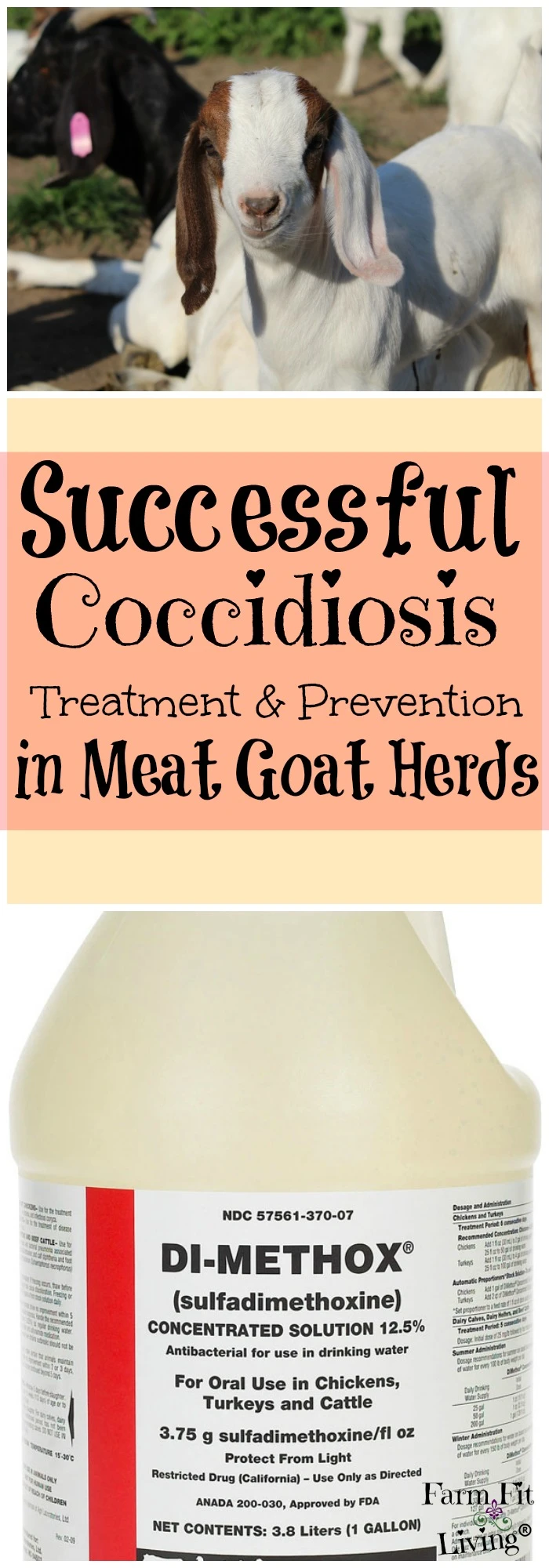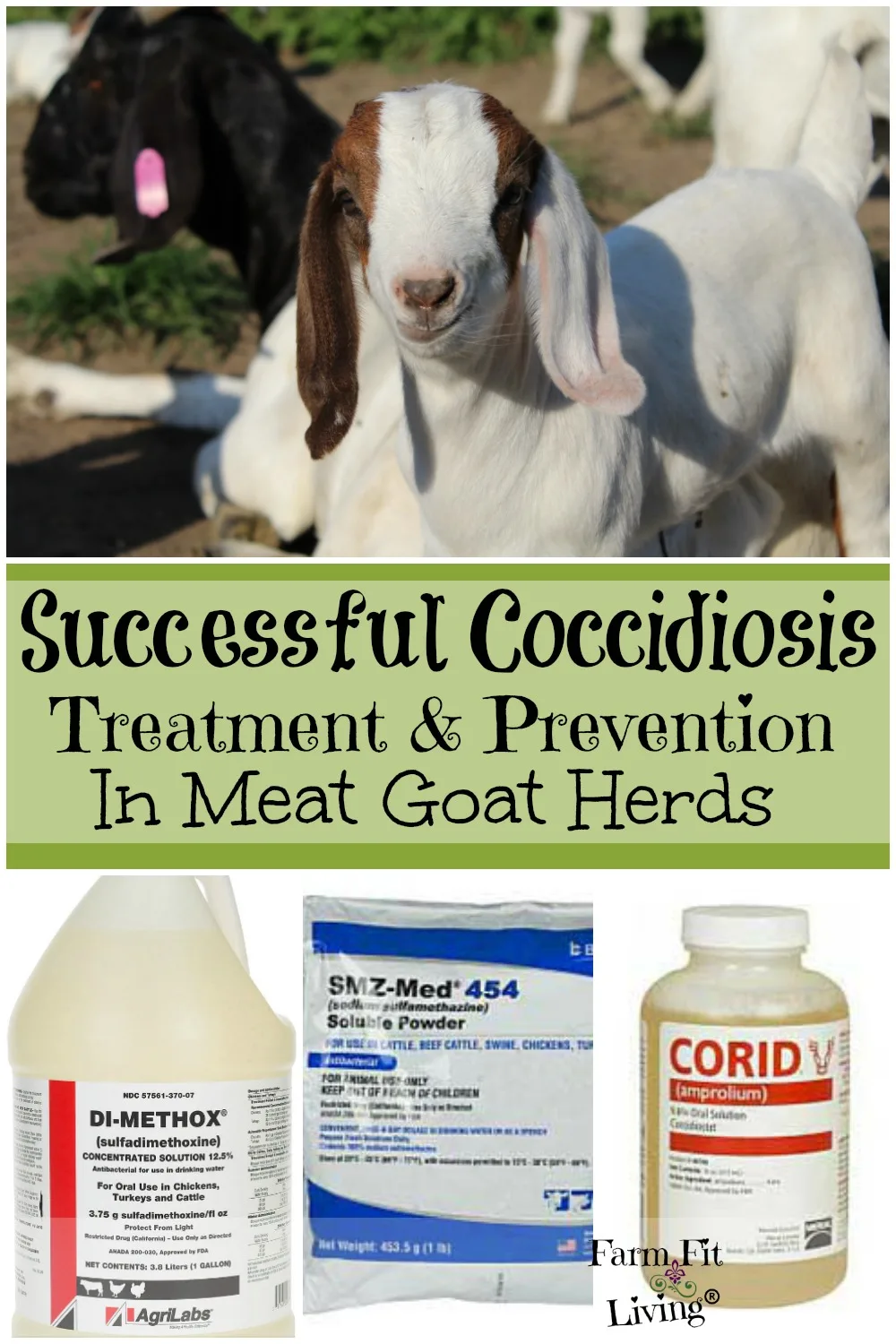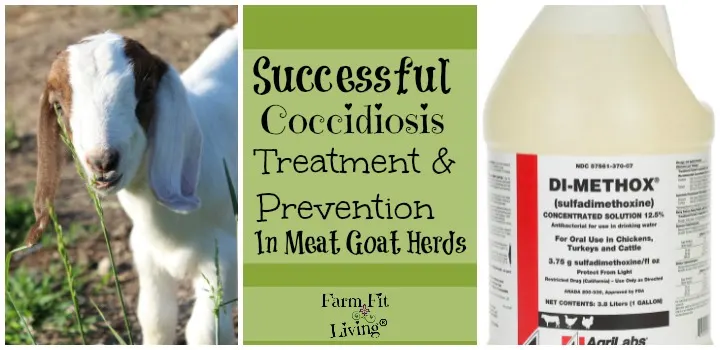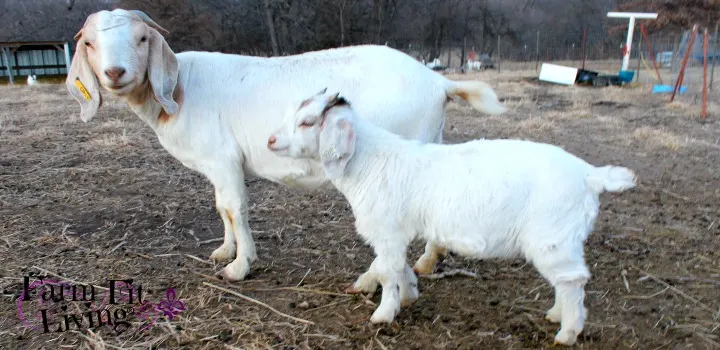Are you trying to determine a successful coccidiosis treatment in your meat goat herd?
Successful coccidiosis treatment protocols are always good to know. Why? Because coccidia bloom which results in coccidiosis results in a mess. So, you want to be prepared for a potential outbreak meat goats by knowing first the symptoms.
Then, learn how to try to prevent and treat it.
So, I will share with you all of these parameters plus my successful coccidiosis treatment protocol.
Listen to the Podcast
First of all, what is coccidiosis? Well, coccidiosis is caused by a bloom of microscopic protozoa (Coccidia) found in the intestines. It’s elevated to dangerous levels of full-blown Coccidiosis when the animal is stressed. Factors elevating coccidiosis include:
- dirty/wet pens
- filthy drinking water
- eating off the ground
- Becoming overcrowded
- Stress
More often than adults, it affects younger kids. Young kids aged 3 Weeks – 6 Months of age are affected.
But why so young?
Two reasons:
- Because they have an immature immune system
- Or they are stressed from weaning.
So, once the protozoa levels increase rapidly with stress through the herd, it’s like a domino effect. One right after the other.
Hence, to control more outbreaks of Coccidiosis, you must first know the symptoms of coccidiosis. Then, discover successful coccidiosis treatment options you can use to stop the outbreaks and have a healthy herd once again.
This post contains Affiliate Links. This means if you click and buy, I might make a commission at no cost to you.
See my policy for more information
First of all, Symptoms of Coccidiosis
Here are the yucky symptoms:
- Diarrhea or runny stools is usually one of the first symptom. Diarhea may look watery and contain mucous or blood – could look almost black.
- Next, weight loss. I notice the goat has lost weight. If the goat is sunk in and losing weight, I consider coccidiosis as a possibility.
- Stunted Growth…Animal is eating enough but not growing well.
- Then, dehyration. If the animal has diarhea, it could become dehydrated.
- Finally, fever. Take the goat’s rectal temperature using a digital thermometer. Normal temperature is (101.5 degrees F to 103.5 degrees F).
And since coccidia is a protozoa, it can only be seen and determined under a microscope. So, fecal sampling is your first move.
Therefore, you could:
- Gather a fecal sample from your goat and take it to your veterinarian.
- Or you could do your own fecals. If you do your own fecal counts, look for the protozoa oocysts (eggs).
Again, if you don’t have your own fecal testing equipment, take a sample to your veterinarian. It’s always best to know for sure if the goat has the disease before you take the time and spend the money to successfully treat coccidiosis.
So, time is of the essence here. The protozoa can take over the goat’s body extremely quickly if not controlled. Now that you know the symptoms and have determined coccidiosis, it’s time for those successful coccidiosis treatment options I promised you.
Treatment Options for Coccidiosis
First of all, the main thing to note is that coccidia is NOT a worm. It is a protozoa. Therefore, dewormers do not cure nor prevent coccidiosis. This is a mistake made time and time again by new goat owners and veterinarians. Myself included.
So, I’m going to share with you what I have learned so you don’t make my mistakes.
I am going to share some successful protocols that were given to me by my expert goat mentor, verified by my veterinarian.
Please note before you read any further: I have a great client-veterinarian relationship with my veterinarian. Therefore, I run every protocol and treatment method by him to be sure it’s the most up-to-date and safe regiment for my animals.
So, the next section will cover four product options for successful coccidiosis treatment options you can check into for your own herd.
Disclaimer: I am not a veterinarian. However, I do have a 4 year degree in Animal Science & Industry from a University, a Master’s degree in Agricultural Education & over a decade of experience raising goats. I believe it’s my duty to share those experiences with other goat producers. I work very closely with my own veterinarian whom I trust and seek advice from on the regular. Both of us are human beings – Not Super Heros. Read more here…
Treatment Product Options
First of all, you need to be using a coccidiostat or sulfa drug.
So, I’m going to give you a couple of products that will combat the protozoa effectively. So, I do not use all of these products. I use one that was recommended by many as well as my veterinarian. You should only stick with one until it doesn’t work anymore.
But, I want to mention other products as well that I know have worked for other producers as well. First of all, you need to know that this protozoa is indeed the problem.
So, the first order of combat is to target the protozoa. If it’s indeed the main problem at hand, verify it by taking fecal sample to the vet to test for coccidia. Read this post on how to prepare a fecal sample.
Ok, let’s jump ahead now. Your goat’s fecal sample says there’s a load of coccidia. What do you do?
Luckily, there are recommended products used for coccidiosis outbreaks. These include:
- DiMethox 12.5% (Oral Drench) or 40% (injectible given orally) – Need a veterinarian prescription. I use the 12.5% solution.
- Sulmet – May need a veterinarian prescription.
- Baycox – I don’t have much to say about it except that I know several producers who are using it.
- Corid – Can purchase at just about any farm store. Should use Vitamin B-12 Complex with it.
So, now you know the hot products on the market for successful coccidiosis treatment. But, you’re wondering how much to give. Let’s get into dosage, shall we?
Dosages for Treatment: DiMethox
Many goat producers have the DiMethox 12.5% on hand to treat coccidia. My veterinarian recommends this one and has it on hand for me to purchase. So, it’s the one I use.
DiMethox 12.5% solution is my #1 pick for treating coccidiosis effectively. Many producers use this as well. While it comes in liquid and powder form, I prefer liquid drenching to make sure each affected animal is receiving the recommended dosage.
The dosage for succesful coccidiosis treatment using the DiMethox 12.5% is 1.6 cc per 5 pounds for 5-7 days in a row.
Also, Di-Methox 12.5% could also be added to drinking water; follow package directions. However, I’m not a fan of adding to drinking water because I’m not sure how much medication the animal is receiving to successfully treat coccidiosis. I would rather exactly how much by drenching.
Consequently, Dimethox 40% is considerably stronger than the usual 12.5% drinking water solution. So, you can use 1/3 as much of the 40%. The dosage is 1 cc per 15 pounds for at least 5 days and no more than 7 days.
Next, I’ll give you a recommended dosage for Baycox if that’s the one you choose to use for successful coccidiosis treatment.
Dosage for Treatment: Baycox (Toltrazuril)
If you’re looking for successful coccidiosis treatment and prevention in young kids, many goat producers will recommend Baycox. It’s a one-time dose, which is why producers like it.
But, there’s still a repetition if you use it. Here’s why.
First of all, something you need to know is that the life cycle of coccidia is 21 days or three weeks. Therefore, for prevention, many producers will start treating their kids at a few weeks old and then give another dosage every three weeks.
Also, you could repeat the treatment in 10 days if you still have an outbreak.
So, the dosage recommended is 1 cc per 5 pounds. Again, I’ve not used this but many other goat producers have successfully.
Now, for the dosage treatments for Sulmet and Corid.
Dosages for Treatment Options: Sulmet & Corid
Sulmet is another sulfa-based medication that many producers use to treat coccidiosis with much success. It is a powder base, so here’s how to mix:
- Dissolve 1 and 1/4 teaspoons powder into 1 cup of water.
- And the dosage is 1 cc per 5 pounds for 5 to 7 days.
By day 3, most goats start coming around and responding to treatment. Be sure to treat for AT LEAST 5 DAYS no matter what.
Finally, Corid is a medication that is readily available. You can purchase it here and at Tractor Supply Company. I don’t recommend using Corid unless you have Vitamin B12 Complex on hand because Corid is a Thiamine inhibitor.
Veterinarians still recommend Corid as a successful coccidiosis treatment option. So, that is why I’m including it in this post.
Here’s the dose recommendations for Corid:
- 6 cc per 25 pounds
- 12 cc per 50 pounds
- 18 cc per 75 pounds
- 24 cc per 100 pounds
As a long-time goat producer, I do not recommend using CoRid. Why? Because it is a thiamine inhibitor. The use of it could eventually lead to other problems, such as Polio.
So, as long as you supplement the B-12 Complex, you shouldn’t have any problems with thiamine becoming deficient in your goat.
Recovery of Extreme Cases
So, I’ve just explained several successful coccidiosis treatment options. Any of these should do the trick if you catch symptoms early and begin treatment.
However, extreme cases can cause fever, dehydration and extreme diarrhea. Therefore, there may be a need for further treatment:
- First of all, an antibiotic, such as LA-200, Nuflor or Biomycin. Check with a veterinarian for proper antibiotic and treatment dosage.
- Probiotics is never ever a bad idea to repopulate the goat’s gut with live bacteria. Use an oral probiotic for ruminants.
- Then, please recoat the lining of the tummy using 5 cc Pepto-Bismol or Kao Pectate given orally.
- If there’s a fever (normal is 101.5 degrees F to 103.5 degrees F), use prescription banamine. (see more below)
- Finally, for dehydration, an electrolyte can be used, such as ReSorb. You can also use Gatorade or Pedialyte if cattle electrolytes are not available.
Important: Do not give probiotics concurrent with antibiotics. Give probiotics only after you complete the consecutive day antibiotic treatment.
To reduce any fevers, banamine is an excellent prescription medication to have on hand. It is great for both calming the gut and bringing down fever. Normal goat body temperature ranges from 101.5 degrees F. to 103.5 degrees F. Determine the goat’s temperature rectally by using a digital thermometer.
Also, banamine should be administered intramuscularly (IM) or sub-cutaneously (SQ). Please double check the dose approved in goats with your vet. Banamine can cause stomach ulcers if over used or used in a way not directed by a veterinarian.
Rehydrating is extremely important. Stomach tubing may be a necessary measure to administer proper electrolytes for rehydration.
Over time, medication protocols will evolve and change. Coccidia will become resistant to certain ones as time goes on unless they continue to be used correctly.
Prevent Coccidiosis from Happening
Coccidia sounds awful, doesn’t it? Fortunately, there are a few things the goat producer can do to try to prevent coccidiosis from even happening.
Proper nutrition is the icing on the cake for prevention and for recovery. Green leaves and vegetation are the best natural product to feed to a sick goat. And green leaves will be the first food that it will eat, followed by hay.
Also, good mineral is another important part of a goat’s nutrition. Nutrition is key to raising a healthy goat herd.
Here are some other ways to try to prevent coccidiosis:
- First of all, make sure feed has a coccidiostat to prevent an outbreak.
- Feed up off the ground.
- Keep animal pens clean and under-crowded.
- Try this lower stress weaning method I use.
- Rotating pastures. Plenty of clean pasture spots is essential with raising goats. Clean pastures are an important measure to successfully treat coccidiosis.
Please Note: The coccidiostat in the feed does not treat an outbreak. So don’t go running to buy a medicated feed to treat your goats’ coccidiosis problem. It’s only for prevention.
But, no matter how hard you try to prevent or successfully treat coccidiosis, your herds are still at risk. Coccidia is always there. Goats will always carry a manageable load in their gut.
In conclusion, you need to be ready. It’s best to just be aware of the symptoms and treatment options available for proactive and responsible combat against this nasty protozoa.
Wrap Up & Resources
Friend, if you know of somebody who needs to hear this message, please take the time and share it with your friend. If you never want to miss a single episode ever again, you can also subscribe and listen for free at:
– Apple Podcasts
– Spotify
– Podbean
– PlayerFM
– Deezer
Subscribe to the podcast and leave us a five star review. I would absolutely love that so much. It would help others who might be looking for topics like this to be able to find our podcast. It would share the podcast with more eyes and ears that need to hear our messages.
You know the message: You deserve to live and work the way you want to without the worry, without the fear and the overwhelm. Here are some great resources to help you today:
– Merck Vet Manual
– Michigan State University
– North Carolina State University
And that’s why I’m here today, my friend. To help and serve and teach you what I have learned to make your life a little bit easier and your time more manageable.
So my friend, thank you again so much for listening.
~ Much Love ~







